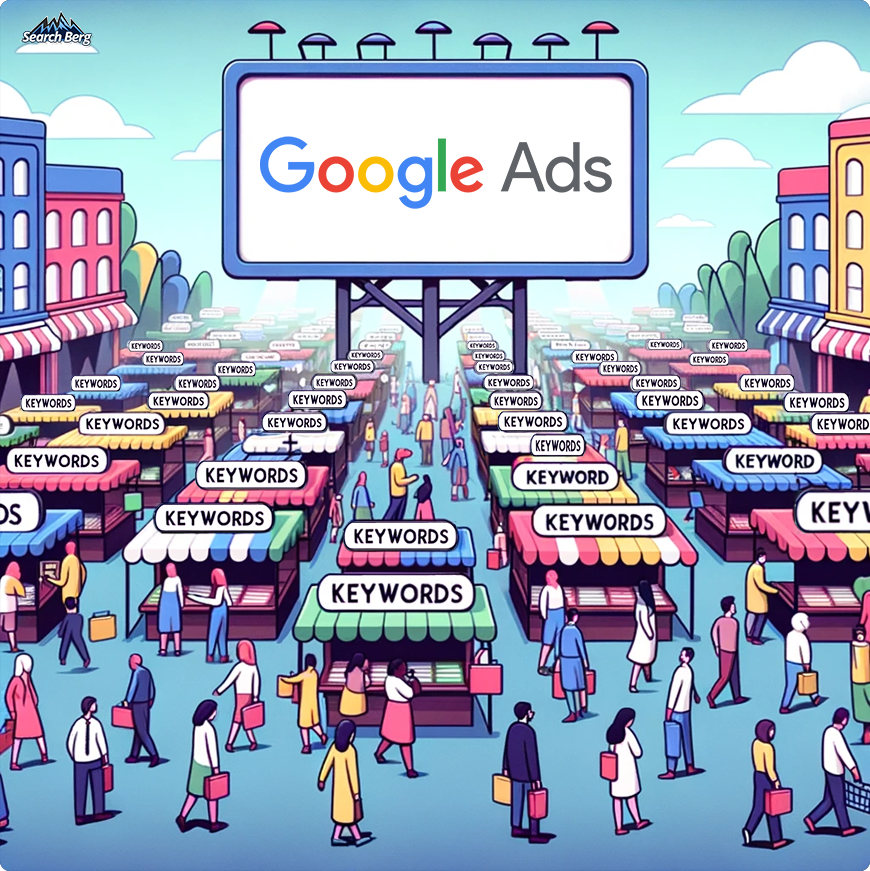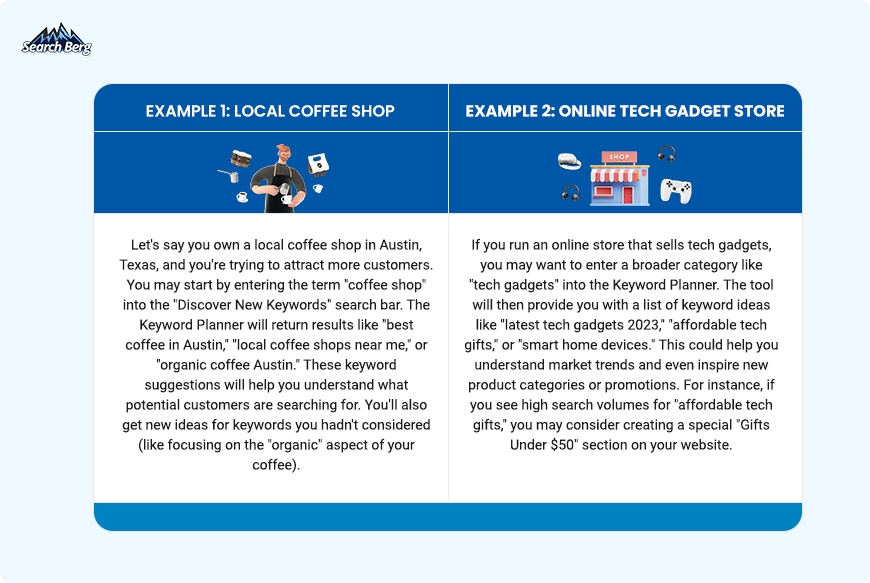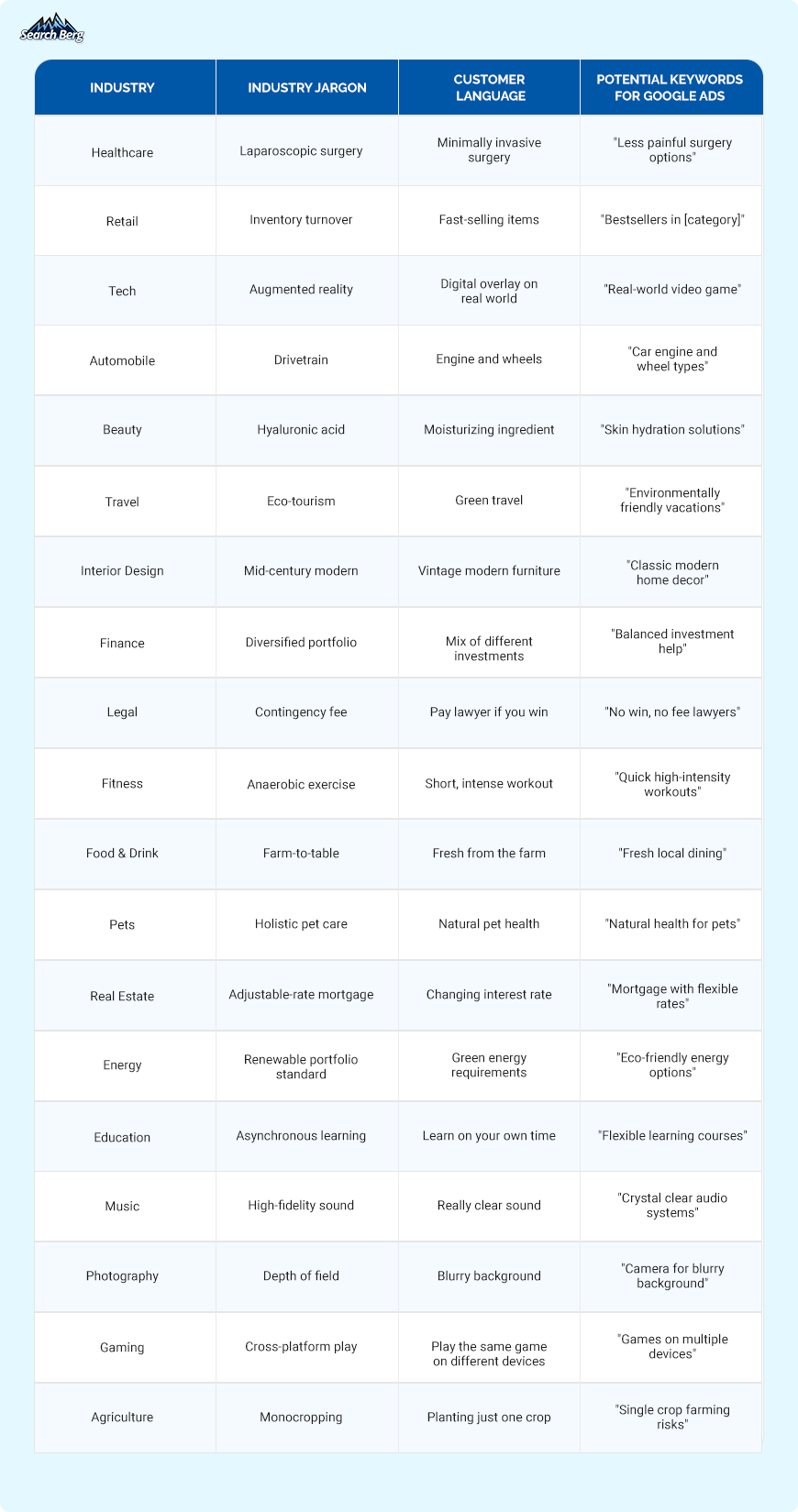How to Find the Right Keywords for Google Ads

Ah, the life of a small to medium-sized business owner. Where “9-to-5” is a myth and multi-tasking is your middle name.
You’ve got products to sell, a brand to build, and, wait, what’s that? Time to set up a Google Ads campaign? Terrific! Just when you thought you could catch a break and sip that cold coffee you’ve been neglecting.
You know that Google Ads could be a game-changer for your business. But where do you even start?
The answer is easier and shorter than you may think: Google Ads keywords. They’re like the GPS coordinates to your treasure chest of ROI. But pick the wrong ones, and you’ll end up sailing the treacherous seas without a map. You might as well be throwing your hard-earned money into the wind!
We’re here to make sure that doesn’t happen.
Join us as we help you master the Google Ads keywords ropes. How can you choose the right keywords? Why is this so important to begin with? And why is effective Google Ads management such a pivotal part of the process?
We’re breaking everything down.
1. Google Ads Keywords: What’s the Fuss All About?
You may have heard the term “keywords” thrown around like confetti at a New Year’s Eve party. But here’s the thing: in the realm of Google Ads, keywords aren’t just decorative sparkles; they’re the cornerstone of any successful advertising campaign.
In its simplest form, a keyword is a word or set of words that a web user types into a search engine (like Google) when looking for a product, service, or information.
But wait, there’s a lot more to it than meets the eye.
Think of Google as a colossal library and your Google Ads account as books in that library. Keywords are essentially the library catalog system (your Dewey Decimal, if you will). When a user types a query into the search bar, Google’s algorithms dash through this immense library to pull out the most relevant “books” or, in your case, ads.
The better you’ve categorized your ad with the right keywords, the higher the chance of your ad appearing in front of eyes eager to read (or click on) it.
Now, why is Google Ads keyword selection so important? For starters, choosing the right keywords directly impacts ad visibility. If you run an online pet store, bidding for a keyword like “pet food” could position your ad alongside other giants in the industry.
However, that’s just scratching the surface. Keywords also influence the cost-effectiveness of your campaign. Opt for too broad or too competitive keywords, and your budget will dwindle faster than you can say “Google it.”
On the flip side, incredibly niche keywords may not get enough search volume to even register a blip on your revenue radar!
Here’s a quick example to make this point more vivid. Let’s say you run a boutique hotel in New Orleans, and you’re looking to attract tourists. If you opt for a broad keyword like “hotel,” you could end up competing with every Tom, Dick, and Hilton in the world.
Your ad might show up.
But so will hundreds of others!
On the other hand, if you go for something more specific like “boutique hotel in French Quarter New Orleans,” you’re narrowing down the competition and targeting the precise audience that would be most interested in your offer.
You’re not just casting a net; you’re spearfishing for the biggest, juiciest, tastiest catch.
So, what’s the fuss all about?
Keywords in Google Ads aren’t just one element of your campaign; they’re”the” element that glues everything together. They help you get the right eyes on your ad at the right time (without making your budget wave a white flag).
They determine your ad’s visibility, click-through rates, and even your cost per click.
They’re the unsung heroes who work behind the scenes by connecting you to clients who are already on the hunt for what you offer. The outcome? A greater potential for high conversions.
Choosing the right Google Ads keywords is akin to choosing the right location for a brick-and-mortar shop.
You wouldn’t set up a high-end art gallery in a deserted alley, would you? Similarly, you wouldn’t want to place your finely crafted ad where it doesn’t belong.
Understanding and implementing the right keywords isn’t optional; it’s imperative for Google Ads success.
Recommended Read: Mastering Google Ads Campaign Settings: An Ultimate Guide
2. Google’s Keyword Planner: The Holy Grail of Keyword Research

Google’s Keyword Planner is a fundamental tool for anyone serious about optimizing their Google Ads keywords campaigns.
It’s like the Swiss Army knife for keyword research, offering a range of features that help you discover new keyword ideas, understand keyword trends, and make informed decisions about which keywords to include in your campaigns.
All of this comes straight from the source, Google itself, meaning you’re working with reliable data.
First things first, to access the Keyword Planner, you’ll need a Google Ads account. Once logged in, navigate to the “Tools & Settings” tab, then choose “Keyword Planner” under the “Planning” section. The interface offers two main options: “Discover New Keywords” and “Get Search Volume and Forecasts.”
2.1. Discover New Keywords
This feature allows you to enter a topic, URL, or a list of keywords. Once you’ve done this, the tool will generate a list of keyword ideas along with critical metrics like average monthly searches, competition, and the estimated cost per click (CPC).
The keyword ideas generated often include variations of the keywords you entered, synonyms, and related industry terms. This is especially useful for expanding your keyword list and discovering new angles to approach your audience.
Here are some examples of this feature in action:

2.2. Get Search Volume and Forecasts
This feature is great for businesses that already have a list of keywords for AdWords and are looking to understand their performance. It provides you with historical metrics and future performance forecasts (like estimated clicks and estimated impressions) based on your budget and bid strategy.
While these features are quite robust, it’s important to look at some of the key metrics the Keyword Planner provides and understand what they mean:
- Average Monthly Searches: This gives you an idea of how often a particular keyword is searched. A high number suggests the keyword is popular, but be wary; high popularity often means high competition and higher costs.
- Competition: Displayed as “low,” “medium,” or “high,” this indicates how many advertisers are bidding on the keyword. High competition often translates to higher costs but could also mean the keyword is valuable.
- Ad Impression Share: This shows the number of impressions your ads are expected to receive compared to the total available impressions for that keyword.
- Top of Page Bid (Low Range and High Range): These estimates give you a sense of how much you’ll have to bid to push your ad to the top of the first page of search results.
- Organic Impression Share and Organic Average Position: These are more relevant for SEO than PPC but can give you an idea of your website’s visibility in organic search for a particular keyword.
2.3. Benefits and Pitfalls
Google’s Keyword Planner is an indispensable tool for anyone looking to dig into the trenches of Google Ads keyword research.
On the benefits front, it’s a goldmine of data directly from the horse’s mouth: Google itself. Unlike third-party tools, the Keyword Planner boasts a high level of reliability and accuracy, giving you the confidence to proceed with your keyword strategies.
The tool allows for intricate audience targeting, letting you filter results based on parameters like location, language, and even search networks. This makes it exceptionally valuable for businesses that serve a localized or specialized market.
Another significant benefit is its cost-effectiveness. It’s a free tool integrated into your Google Ads account, which means you don’t need to shell out extra bucks for basic keyword research. This is a considerable relief (especially for small to medium-sized businesses running on tight budgets).
It also features historical trends, helping you identify seasonal fluctuations or shifts in consumer behavior over time.
However, despite its numerous advantages, Google’s Keyword Planner has its fair share of pitfalls. One of the most glaring drawbacks is its complexity.
For someone new to Google Ads, the plethora of features and metrics can be overwhelming. It’s a bit like being handed the control panel of a jet plane on your first flying lesson. Without adequate know-how, you may not be able to leverage the tool to its full potential, leading to suboptimal campaign performance.
Additionally, the Keyword Planner often leans towards broader, more competitive keywords. These may bring in high traffic but don’t necessarily guarantee high conversion rates. Since the data is available to everyone, including your competitors, there’s a risk of saturating the market with similar keyword strategies, which can drive up the bidding prices for those popular keywords. Yikes.
This is where turning to a professional Google Ads service provider can be a game-changer. Google Ads management professionals are adept at navigating the intricacies of the Keyword Planner. They also bring industry-specific insights that can give your campaign an edge.
They can analyze your business needs, customer behavior, and market trends to select Google Ads keywords that deliver both traffic and conversions. By doing so, they free you from the cumbersome task of sifting through heaps of data, allowing you to focus on what you do best: running your business.
Turning to trusted Google AdWords management services can help you harness the tool’s full power in crafting a keyword strategy that attracts clicks and drives conversions. No errors, no fuss, just terrific results.
Recommended Read: 10 Tips to Optimize Your Google Product Listing Ads
3. Season Your Strategy with Long-Tail Keywords

When it comes to cooking up a delicious Google Ads keywords campaign, many chefs (uh, marketers) reach for the table salt of the keyword world: short, generic keywords. They’re the “pasta,” “chicken,” or “salad” of online advertising.
Sure, they’re staples and can be satisfying, but they’re also a bit bland and highly competitive. Before you know it, they’ll quickly eat up your budget like a hungry teenager at a buffet.
So, what’s the secret ingredient that can elevate your dish (err, campaign) from good to gourmet? The answer’s short and sweet: long-tail keywords.
Long-tail keywords are the saffron and truffle oil of your keyword strategy. These phases usually consist of three or more words; they’re incredibly specific. Think of them as the opposite of generic, broad keywords. Instead of “running shoes,” a long-tail keyword would be “best cushioned running shoes for flat feet.”
You’re not just identifying a product; you’re honing in on a niche, meeting a specific demand, and reaching a customer who’s closer to making a purchase decision.
Now, let’s dive into the benefits that make these specific keywords your secret seasoning:
- Less Competition, Lower Costs: Since long-tail keywords are more specific, fewer competitors are vying for them, resulting in lower bid costs. This means you can still reach your desired audience without having to mortgage your office furniture.
- Higher Conversion Rates: Someone searching for “best cushioned running shoes for flat feet” is probably closer to making a purchase than someone just searching for “shoes.” Long-tail Google Ads keywords target users who are further along in the buying process, increasing the likelihood of conversions.
- Enhanced User Experience: Using long-tail keywords means your ad is more relevant to the searcher’s query, improving their overall experience. It’s like being handed a gluten-free menu at a restaurant when you’re gluten intolerant; you feel understood and are more likely to stick around (or click)!
- Rich Source of Content Ideas: Long-tail keywords can be content goldmines. They provide insights into your audience’s questions or problems. You’ll be able to create highly relevant content that speaks directly to those needs.
- Easier to Rank For: With less competition, it’s often easier to achieve higher rankings in search results with long-tail keywords for AdWords. And we all know that higher rankings translate to more clicks and conversions!
Now, before you jump into the deep end of the long-tail pool, take a few steps back and figure out where you can find these gems.
Keyword research tools (like Google’s Keyword Planner) can help you discover long-tail opportunities. The trick is to look beyond the search volume and consider the user intent and potential for conversion.
Also, don’t shy away from using conversational phrases or questions; remember, voice search is on the rise, and these are the types of queries people use when speaking to their voice-activated devices.
Of course, you must strike a balance. Your keyword strategy shouldn’t solely comprise long-tail keywords (just as a gourmet meal isn’t just made of saffron and truffle oil). When used judiciously, long-tail keywords can add that extra kick that takes your Google Ads keywords campaign from ho-hum to oh-yum.
4. Analyze Your Competitors (Legally, Of Course!)

In the business battlefield, information is power. Knowing what your competitors are up to can give you that essential edge to outperform them.
But before you don your virtual trench coat and shades, let’s be clear: we’re talking about ethical espionage here. Forget hacking, wiretapping, or any other shadowy techniques; the tools and strategies we’re discussing are all above board.
Spying on your competitors isn’t just about satisfying your curiosity. It’s a smart strategy that can yield a high return on investment.
By understanding the specific Google Ads keywords your competitors are targeting, you can identify gaps in your strategy, refine your ad copies, and even discover new market segments they may be overlooking. This kind of data can illuminate your path to increased profit and business growth.
Google Ads is a great starting point. The “Auction Insights” report provides a snapshot of how your campaigns compare with other advertisers’ campaigns for the same keywords for AdWords.
Metrics like “Overlap Rate,” “Position Above Rate,” and “Top of Page Rate” can provide valuable insights into how frequently your ads appear compared to your competitors’ ads, how often they appear above yours, and how often they appear at the top of the page.
You can also employ the tried-and-true method of simply using Google Search. Type in keywords relevant to your business and examine the ads that pop up. Take note of the headlines, descriptions, and any extensions they’re using.
This won’t give you any quantitative data, of course. However, a qualitative approach can offer a surprising amount of actionable insight.
After you’ve gathered this intel, what’s next?
First, dissect the competitor’s keywords that are relevant to your business. Are they targeting long-tail keywords that you hadn’t thought of? Or perhaps they’re focusing on a particular niche market that you’ve overlooked?
Integrate these findings into your existing Google Ads keywords campaigns for testing.
Next, scrutinize the ad copies. What kind of language are they using? What kind of emotional triggers do they pull? Don’t copy them outright; that’s neither ethical nor effective. Instead, find ways to adapt their successful strategies to fit your unique brand voice and offerings.
Lastly, consider the customer journey. If a competitor is consistently outperforming you, examine their landing pages, customer experience, and product offerings.
Sometimes, the keyword is just the tip of the iceberg; the real competitive edge comes from a finely-tuned sales funnel.
By taking the time to analyze your competitors ethically and strategically, you’ll get a shortcut to understanding what works in your industry and what doesn’t. This invaluable knowledge can help you avoid mistakes and make more informed decisions.
If you need a hand, turn to Google Ads management services. Google Ads service providers wield a variety of specialized tools designed to dissect competitor strategies without crossing any ethical boundaries. These tools can give you a granular look at everything from the keywords your competitors are targeting to the kind of ad copy that’s driving their conversions.
Recommended Read: SEO Services vs. PPC Advertising: Which is Better for Your Business?
5. Think Like Your Customers
If you want to find the right keywords for AdWords, you’ll have to do more than just crunch numbers and analyze graphs. You’ll need to master the fine art of empathy.
By stepping into your customer’s shoes, mentally and emotionally, you’ll gain a nuanced understanding of their needs, concerns, and search habits. This empathy-driven approach is indispensable for crafting a Google Ads keyword strategy that truly resonates with your target audience.
Here’s how to do it.
5.1. Unearth the Pain Points
Any successful business solves a problem or addresses a need. That’s Business 101 right there. But when it comes to Google Ads keyword research, understanding the specific problems your potential customers are trying to solve can be a goldmine.
Take a moment to list down the pain points your product or service addresses. Is your accounting software designed to simplify tax filing for freelancers? Then, terms like “easy tax software for freelancers” could be right up your alley. Are you selling ergonomic office furniture? Keywords like “best chairs for back pain” could be winners.
But don’t just rely on your assumptions; make data-backed decisions. Dive into forums, social media, and customer reviews related to your industry. Listen to the language people are using to describe their problems and needs. More often than not, these are the exact phrases they’ll type into a search engine.
Let’s consider the case of a local organic grocery store aiming to expand its customer base through Google Ads. They specialize in delivering fresh, locally sourced, organic produce right to the customer’s doorstep. What are some of the pain points their potential customers might experience?
First, the business owner decides to comb through recent customer reviews and discovers phrases like “tired of supermarket fruits that go bad in a day” and “hard to find quality organic produce nearby.” These comments give the grocery store valuable clues about what their customers are genuinely concerned about: the longevity of produce and the availability of organic options.
Next, they engage in social listening and find out that many local residents are tweeting and posting about wanting to support local farmers but not knowing how. Phrases like “how to support local agriculture” and “local farmers near me” pop up frequently.
Lastly, by visiting forums dedicated to organic living, sustainable agriculture, and local food, they notice common questions like “where to find farm-fresh produce?” or “best organic grocery delivery?”
From these efforts, the business owner can deduce several pain points. The store can now create a list of potential keywords for AdWords. Here are some examples:
- “Long-lasting organic fruits”
- “Local organic grocery delivery”
- “Support local farmers”
- “Quality organic produce near me”
By genuinely understanding their prospective customers’ pain points, the organic grocery store can craft a Google Ads keywords campaign that doesn’t just reach people but resonates with them, making them far more likely to click and, ultimately, convert.
5.2. Decode the Search Intent
Search intent goes beyond the words typed into a search box; it delves into the “why” behind the search.
Are they looking for information (“what are the symptoms of a migraine?”), a place (“best pizza place near me”), or a specific product (“buy iPhone 15 online”)?
Understanding the intent behind keywords can help you align your Google Ads more closely with what your potential customers are actually looking for.
For example, if you’re a personal trainer, and your target audience frequently uses the term “lose weight at home,” they’re probably not interested in a gym membership. Tailoring your ads to focus on at-home workout plans could significantly improve your conversion rates.
Search intent tells you more than just what your audience is looking for; you’ll also learn how and where they want to find that solution.
5.3. Language and Lexicon Matters
Every industry has its jargon, but that doesn’t mean your customers are fluent in it!
They may not know they need “search engine optimization”; they may think they just want to “show up on Google.” They may not realize they’re looking for “ergonomic furniture” when they’re suffering from “back pain from office chair.”
If you want to think like your customer, you’ll have to speak their language.
Keep an eye out for phrases and questions your customers use during sales calls, emails, or social media interactions. These can often be converted into long-tail Google Ads keywords that capture the essence of your customer’s concerns, questions, or needs.
This is what we’re talking about:

6. Localize, Localize, Localize!
Ah, locality: a word so nice, we’ve got to say it thrice!
Localizing your keywords is like having a friendly neighborhood Spider-Man; you swing directly into the lives of those who matter most to your business.
Let’s dissect why this hometown hero strategy is so important and how you can put it into action.
6.1. The “Why” Behind the Local Lingo
Now, you may be asking, “Why focus on local Google Ads keywords?” The answer is simple: specificity equals relevance.
When you opt for general or global keywords, you’re essentially throwing a big net into an even bigger ocean.
Sure, you might catch something, but will it be what you really want? Probably not.
You’ll likely end up with a smattering of clicks from people scattered across different continents, time zones, or states. These aren’t necessarily the people who are going to walk into your store, attend your local event, or even shop on your online store with shipping costs in mind.
In essence, you might get visibility, but not the kind that translates into actual sales or conversions.
Local keywords are highly targeted; they aim your ad content directly at the consumers most likely to take action: your neighbors, your community, and the local fan club you never knew you had.
These are the folks searching for immediate solutions: the woman looking for an emergency plumber close by, the couple craving sushi “near me” for their date night, or the parent scouting local summer camps for their kids.
These searches are imbued with intent (the kind that leads to quicker decisions and, consequently, sales). You’re not just getting in front of eyes; you’re getting in front of the right eyes. Local Google Ads keywords are the low-hanging fruits you should definitely be picking.
It’s also worth noting that local keywords often have less competition compared to broader terms; this makes them a cost-effective choice. Think of it as a VIP pass to a club everyone wants to be in. While others are jostling at the crowded global door, you breeze through the local entrance, welcomed by an audience that’s been waiting for what you offer!
And let’s not overlook the benefit of local credibility. When your business appears in local searches, you’re seen as a community member, not just a faceless entity. This local focus builds trust and fosters relationships, ultimately transforming one-time transactions into loyal, long-term customers.
6.2. Local Keywords = Local Business
So, you’ve wrapped your head around the notion that local keywords are essential for capturing the attention of potential customers in your area. That’s a start.
But how does one go about discovering these magical, business-driving phrases?
1. Research Away!
It all starts with thorough research. You can’t figure out which local keywords will resonate with your audience if you don’t know what they’re searching for in the first place.
Check Google Analytics to see if you’re already getting local hits from certain phrases or terms. Take a look at local events or trends that could be leveraged into your Google Ads keyword strategy. You can even initiate customer surveys or quick polls to get into the heads of your community members!
Knowledge isn’t just power here; it’s potential profit.
2. Target Local Needs
Next, think about the specific requirements your product or service meets and how those requirements may be expressed by locals.
For instance, if you own a gym, don’t just go for “best gym”; consider phrases like “[Your Town] gym with childcare” or “[Your Neighborhood] 24-hour gym.”
The point is, your locality has unique features and needs, and your keywords should reflect that.
3. Tap Into Local Culture and Events
Is there a major annual festival in your area? A college that influences the local scene? Use these cultural or event-based elements to inspire your local keywords for AdWords.
If you own a cafe near a university, consider terms like “best study cafe near [University Name]” or “[Festival Name] weekend brunch specials.”
See what we’re getting at?
4. The Local Consumer Journey
Keep in mind that consumers may use different search terms based on where they are in the buying journey. Early on, they may be searching for reviews and comparisons (“best carpenter in [City] reviews”), and as they move closer to a purchase, their searches may become more specific (“[City] carpenter free quote”).
5. Seasonality and Local Keywords
Let’s not forget that different seasons might bring different local events or needs.
A snow removal service might focus on keywords like “emergency snow removal [City]” during winter, while a local clothing store might leverage the start of the school year with “back-to-school sales in [City].”
By focusing on these elements, you can construct a Google Ads keyword strategy that doesn’t just talk at locals but talks to them, addressing their specific concerns, interests, and immediate needs.
After all, local customers aren’t an abstract concept; they’re real people walking down your street, sending their kids to the same schools as you, and participating in the same local events.
They should be talked to in a language they understand based on the life they live daily.
6.3. Implementing Your Local Keywords

Great, so you’ve got a shiny list of local keywords. What now?
Let’s break it down.
1. Keyword Placement Matters
Collecting a list of local keywords for AdWords isn’t enough; you must put them where they’ll do the most good. Your ad’s headline is the first thing a user sees; use your most potent local keyword there.
But don’t stop at the headline. Incorporate local keywords into your ad copy, meta descriptions, and even display URLs. This is a great way to improve your ad’s SEO and reinforce your local relevance to the searcher.
2. Leverage Google Ads Features
Google Ads offers several features to improve your ad’s performance; one of these is location extensions. By using this, you can include your business’s local address, which gives the searcher more context and credibility about your locality.
Let’s say a web user searches for “best Italian restaurant near me,” and your ad shows up with compelling ad copy and your exact location. The closer you are, the more likely they are to choose you over a competitor.
See how this works?
3. Customer Reviews for Credibility
Local reviews can act like your business’s character witnesses in the court of public opinion.
Encourage satisfied customers to leave positive reviews that specifically mention the local aspects they enjoyed (whether it’s your convenient location or your integration into the community).
These reviews can significantly bolster your local Google Ads keyword strategy by adding social proof. They basically scream, “Hey, not only are we local, but your neighbors also love us!”
4. Measure, Refine, Repeat
No keyword strategy is set in stone. The digital landscape is constantly shifting, and consumer behavior is evolving.
Keep a close eye on your Google Ads metrics to determine which local keywords are pulling their weight and which are slacking off.
Google’s built-in analytics tools can show you click-through rates, conversion rates, and even the geographical origins of your clicks. Use these insights to fine-tune your keywords and even your bidding strategy.
If “best coffee in [City]” is your top-performing keyword, it might be worth upping your bid for that term!
5. Think Multi-Channel
Finally, remember that Google Ads is just one part of your broader marketing strategy. Your local keywords can and should be used across multiple channels.
Integrate them into your social media posts, your website content, and even your offline marketing materials like flyers and billboards. The more places your local keywords appear, the more ingrained they become in your overall brand image, reinforcing your position as a local business leader.
7. Don’t Ignore Negative Keywords

While your regular, shiny, optimized keywords are pulling in traffic, you may be neglecting a vital component that filters out irrelevant clicks and can save you a lot of money: negative keywords.
These are the words you DON’T want triggering your ads.
Let’s paint a picture here. Imagine you run a luxury furniture store. You use Google Ads keywords like “designer sofas,” “high-end bedroom sets,” and “luxury home decor.”
Now, every time someone searches for “affordable sofas” or “budget-friendly furniture,” you don’t want your ad to pop up.
Why?
Because someone looking for budget furniture is unlikely to click on your ad, and even if they do, it’s even less likely they’ll convert. In this case, words like “affordable” and “budget-friendly” become your negative keywords.
But why is it essential to filter out these seemingly harmless extra clicks?
Several reasons, actually.
Firstly, and most obviously, is cost. You pay for each click your ad receives. Irrelevant clicks from people who have no intention of buying from you are nothing more than financial sinkholes. These clicks erode your budget without offering anything in return.
Secondly, it’s about ad efficiency. Your keyword strategy isn’t just supposed to attract as many clicks as possible; it’s meant to attract the right clicks.
Every irrelevant click lowers your click-through rate (CTR) and, ultimately, your Quality Score within Google Ads, which is an estimate of the quality of your ads, keywords, and landing pages. A lower Quality Score can affect your ad placement and could result in higher costs per click (CPC). The outcome? A vicious cycle that continuously saps your budget.
Thirdly, high bounce rates from irrelevant clicks can negatively impact your website’s SEO rankings. Google’s algorithms are smart enough to know when users are quickly leaving your website without interacting with it. This is a strong indicator that your site didn’t provide what the searcher was looking for.
It’s also important to note that negative keywords help you hone your advertising focus. Let’s say you only sell organic skincare products. Adding “non-organic” or “chemical” as negative keywords can help sharpen your ad’s focus and ensure they only appear in searches that are truly relevant to what you offer.
And let’s not forget that negative keywords can also help you combat seasonal irrelevance! If you’re a tax consultant, you’re likely not interested in appearing in searches for “Halloween tax costumes.” You can mark seasonal or event-based terms that are irrelevant to your service as negative keywords to prevent wasting your budget.
But there’s a cautionary tale here, too. You have to strike the right balance; being overly aggressive with negative keywords could block some valuable traffic.
Frequently revisiting and updating your negative Google Ads keyword list is as important as updating the keywords you want to target. It’s a nuanced, ongoing strategy that demands as much attention as your main keyword list.
If you feel overwhelmed by the research involved, hire Google Ads management experts who specialize in negative keywords. They’ll take the reins for you.
8. Keep an Eye on Search Trends
We’ve already lightly touched upon search trends before. In this section, we’ll dig deeper.
Trends can be your guiding star in the ever-expanding universe of keywords for AdWords. They can tell you what’s “in” and what’s “so yesterday” in real time, ensuring that you’re riding the wave instead of being crushed by it.
How can you keep a vigilant eye on search trends and make them work for your Google Ads? Let’s dive in.
8.1. Use Google Trends to Your Advantage

If Google Keyword Planner is the bread and butter of keyword research, then Google Trends is the spicy condiment that adds flavor to your strategy.
Unlike Keyword Planner, which gives you raw data on keyword performance, Google Trends shows you the popularity of a search term over time.
You can set the geography and timeframe. In fact, you can even compare multiple terms to see how they stack up against each other!
Brilliant, isn’t it? We think so, too.
Let’s say you own a fitness equipment store, and you’re trying to decide whether to push “treadmills” or “elliptical machines” in your next ad campaign.
Google Trends can show you if one is gaining popularity over the other or if there’s a seasonal trend where one outperforms the other. This information is crucial for making informed decisions.
However, Google Trends isn’t just about the numbers; it can also provide invaluable context.
The “related searches” section shows you other terms people are searching for in relation to your keyword. If you find that a lot of people who search for “vegan recipes” also search for “plant-based protein,” you’ve got yourself another keyword to consider!
8.2. Seasonal Trends and Event-Triggered Spikes
Seasonality and events are another aspect of search trends worth delving into. Some businesses are intrinsically seasonal (think swimwear in summer or tax consultants in April). For these businesses, keyword trends can vary dramatically throughout the year, and your Google Ads keywords strategy needs to adapt accordingly.
But it’s not just inherently seasonal businesses that need to be aware of this. Big events like the Super Bowl, Black Friday, or even something like a royal wedding can cause temporary spikes in certain search terms. If you’re in a related industry, you’d be wise to capitalize on these.
For instance, if you run a bakery and there’s a popular baking show finale coming up, you’d want to ramp up ads featuring keywords like “baking supplies” or “celebration cakes.”
Then, there are news and cultural events. A sudden health scare could drive up searches for “organic food,” or a popular movie could spike interest in a specific period or culture’s clothing. The key is to be agile and ready to pivot your strategy based on what’s trending.
9. Test, Refine, Repeat

This isn’t merely a tagline; it’s a rigorous approach that separates campaigns that thrive from those that merely survive.
First off, you need to understand that no Google Ads keywords campaign is ever perfect right off the bat. Even if you’ve conducted thorough keyword research, examined search trends, and made use of every tool in your arsenal, the actual performance metrics might surprise you.
That’s why it’s essential to start by setting specific, measurable, achievable, relevant, and time-bound (SMART) goals. Whether you’re looking at click-through rates, cost-per-click, or conversion rates, you need to know your targets.
Once you’ve run your campaign for a sufficient amount of time, long enough to gather actionable data, dive into Google Ads’ analytics. This is where you get to view metrics that directly relate to your objectives.
Are people clicking but not converting? Are you getting impressions but no clicks? Each of these scenarios indicates different things and will require different kinds of refinement.
For instance, if you’re getting clicks but no conversions, it could mean that your landing page isn’t up to par or that the keywords you’re targeting aren’t as relevant to your offering as you thought.
On the other hand, if you’re getting impressions, but no clicks, your ad copy may need to be more compelling, or perhaps your bid is too low to get you in front of the right eyeballs.
After identifying areas for improvement, the next step is making those changes. This could involve anything from adding new Google Ads keywords based on trending data to removing underperforming ones or adjusting your bid strategy to better align with your objectives. Work with an experienced Google Ads service provider to make the right adjustments.
But remember, refinement isn’t a one-and-done thing. Consumer behavior shifts, new competitors enter the market, Google’s algorithms change; the list goes on. Consistently reviewing and refining your Google Ads keyword strategy in response to performance metrics and broader changes is a great way to ensure your campaigns continue to perform well.
Finally, the “Repeat” in “Test, Refine, Repeat” is crucial. This isn’t a process you do just once; it’s ongoing. The digital landscape is ever-changing; resting on your laurels means you’ll quickly be overtaken by more agile competitors.
So, how often should you go through this cycle? That largely depends on your business and the competitive landscape. Some businesses may find monthly reviews sufficient, while others in more competitive or fast-changing industries may need to do this weekly.
The key takeaway is that this process is continuous and essential for the long-term success of your Google Ads keywords campaigns.
10. The Power of Google Ads Management Services
Let’s be honest. As thrilling as this adventure has been, it’s also akin to venturing into the Amazon rainforest without a guide. You may have packed the bug spray and sunscreen, but do you really know which way to go when you’re knee-deep in the wilderness?
This is where Search Berg’s Google Ads management services come into play. You see, managing a Google Ads campaign isn’t just about picking some juicy keywords for AdWords and calling it a day. It’s an intricate ballet of analytics, trends, and continuous refinement.
What sets Search Berg apart? Well, besides our expertise and experience, it’s our commitment to your business’s individual needs. We don’t believe in a one-size-fits-all approach because, let’s face it, your business isn’t a “one-size-fits-all” kind of deal.
Whether you’re a mom-and-pop shop looking to bring in local foot traffic or an eCommerce giant aiming for world domination, our Google AdWords management services are tailored to meet your specific objectives. We focus on both Google Ads maintenance and management.
With Search Berg, you’re not just getting a service; you’re gaining a partner: someone who’s as invested in your success as you are. We pore over the data, keep a vigilant eye on emerging trends, and continually refine your campaign for maximum impact.
If you’re tired of playing keyword roulette and ready to turn your Google Ads keywords campaign into a well-oiled, sturdy, profit-generating machine, give Search Berg a call. Our Google Ads service providers will guide you through the mountainous terrain of Google Ads all the way to the peak of ROI nirvana!














